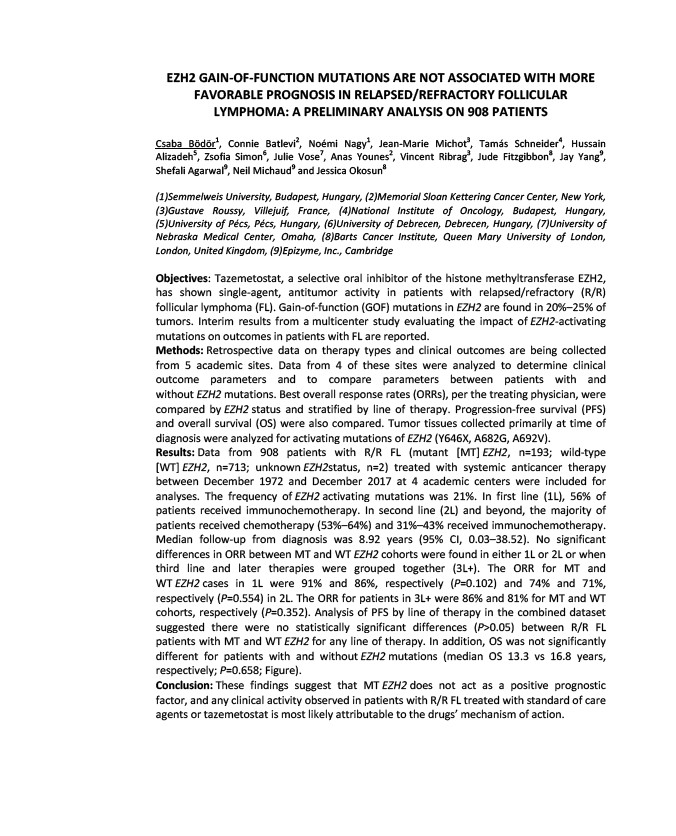
EZH2.GAIN9OF9FUNCTION.MUTATIONS.ARE.NOT.ASSOCIATED.WITH.MORE.
FAVORABLE.PROGNOSIS.IN.RELAPSED/REFRACTORY.FOLLICULAR.
LYMPHOMA:.A.PRELIMINARY.ANALYSIS.ON.908.PATIENTS.
.
Csaba% Bödör1,% Connie% Batlevi2,% Noémi% Nagy1,% JeanUMarie% Michot3,% Tamás% Schneider4,% Hussain%
Alizadeh5,% Zsofia% Simon6,% Julie% Vose7,% Anas% Younes2,% Vincent% Ribrag3,% Jude% Fitzgibbon8,% Jay% Yang9,%
Shefali%Agarwal9,%Neil%Michaud9%and%Jessica%Okosun8%
%
(1)Semmelweis1University,1Budapest,1Hungary,1(2)Memorial1Sloan1Kettering1Cancer1Center,1New1York,1
(3)Gustave1 Roussy,1 Villejuif,1 France,1 (4)National1 Institute1 of1 Oncology,1 Budapest,1 Hungary,1
(5)University1of1Pécs,1Pécs,1Hungary,1(6)University1of1Debrecen,1Debrecen,1Hungary,1(7)University1of1
Nebraska1 Medical1 Center,1 Omaha,1 (8)Barts1 Cancer1 Institute,1 Queen1 Mary1 University1 of1 London,1
London,1United1Kingdom,1(9)Epizyme,1Inc.,1Cambridge1
1
Objectives:%Tazemetostat,%a%selective%oral%inhibitor%of%the%histone%methyltransferase%EZH2,%
has% shown% singleUagent,% antitumor% activity% in% patients% with% relapsed/refractory% (R/R)%
follicular%lymphoma%(FL).%GainUofUfunction%(GOF)%mutations%in%EZH2%are%found%in%20%–25%%of%
tumors.% Interim% results% from% a%multicenter% study% evaluating% the% impact% of%EZH2Uactivating%
mutations%on%outcomes%in%patients%with%FL%are%reported.%
Methods:%Retrospective% data% on% therapy% types% and% clinical% outcomes% are% being% collected%
from% 5% academic% sites.% Data% from% 4% of% these% sites% were% analyzed% to% determine% clinical%
outcome% parameters% and% to% compare% parameters% between% patients% with% and%
without%EZH2%mutations.%Best%overall%response%rates%(ORRs),%per%the%treating%physician,%were%
compared% by%EZH2%status% and% stratified% by% line% of% therapy.% ProgressionUfree% survival% (PFS)%
and%overall%survival%(OS)%were%also%compared.%Tumor%tissues%collected%primarily%at%time%of%
diagnosis%were%analyzed%for%activating%mutations%of%EZH2%(Y646X,%A682G,%A692V).%
Results:%Data% from% 908% patients% with% R/R% FL% (mutant% MT%EZH2,% n=193;% wildUtype%
WT%EZH2,% n=713;% unknown%EZH2status,% n=2)% treated% with% systemic% anticancer% therapy%
between% December% 1972% and% December% 2017% at% 4% academic% centers% were% included% for%
analyses.% The% frequency% of%EZH2%activating% mutations% was% 21%.% In% first% line% (1L),% 56%% of%
patients% received% immunochemotherapy.% In% second% line% (2L)% and% beyond,% the% majority% of%
patients%received%chemotherapy%(53%–64%)%and%31%–43%%received%immunochemotherapy.%
Median% followUup% from% diagnosis% was% 8.92% years% (95%% CI,% 0.03–38.52).% No% significant%
differences%in%ORR%between%MT%and%WT%EZH2%cohorts%were%found%in%either%1L%or%2L%or%when%
third% line% and% later% therapies% were% grouped% together% (3L+).% The% ORR% for% MT% and%
WT%EZH2%cases% in% 1L% were% 91%% and% 86%,% respectively% (P=0.102)% and% 74%% and% 71%,%
respectively%(P=0.554)%in%2L.%The%ORR%for%patients%in%3L+%were%86%%and%81%%for%MT%and%WT%
cohorts,%respectively%(P=0.352).%Analysis%of%PFS%by%line%of%therapy%in%the%combined%dataset%
suggested% there% were% no% statistically% significant% differences% (P>0.05)% between% R/R% FL%
patients%with%MT%and%WT%EZH2%for%any%line%of%therapy.%In%addition,%OS%was%not%significantly%
different% for% patients% with% and% without%EZH2%mutations% (median% OS% 13.3% vs% 16.8% years,%
respectively;%P=0.658;%Figure).%
Conclusion:%These% findings% suggest% that% MT%EZH2%does% not% act% as% a% positive% prognostic%
factor,%and%any%clinical%activity%observed%in%patients%with%R/R%FL%treated%with%standard%of%care%
agents%or%tazemetostat%is%most%likely%attributable%to%the%drugs’%mechanism%of%action.%